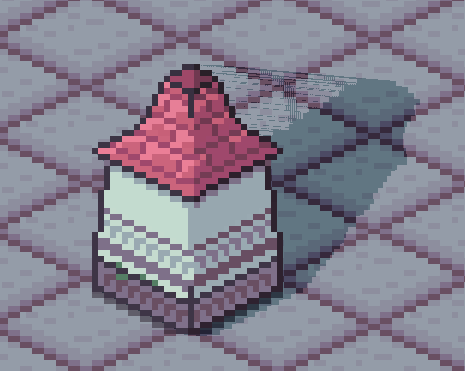|
|
|
 |
Reply From: |
CravateZeus |
Hi, in the meantime I actually came up with a solution that almost works properly :
First I have a simple shader for my sprite where I give it a heighmap. Depending on the color of each pixel in the heightmap, I use the HDR value of that pixel to pass the height information onto another full-screen shader.
I’m sorry if my code is not super clean, I pretty much got my implementation to work by trial and error.
shader_type canvas_item;
uniform sampler2D heightmap;
void fragment(){
vec4 heightmap_tex = texture(heightmap, UV));
if(heightmap_tex.a > 0.9){
// I'am adding 1.0 * h to to that pixel's color, where h
// is the height of that pixel on the heightmap
COLOR = texture(TEXTURE, UV) + vec4(1.0, 1.0, 1.0, 0.0) * (heightmap_tex.r * 255.0 + 1.0);
} else {
COLOR = texture(TEXTURE, UV);
}
}
Then my screen shader knows that if a pixels’color is greater than 1.0, it means it has some height.
shader_type canvas_item;
uniform float xyangle;
uniform float zangle;
void fragment(){
bool isinshade = false;
float dist;
float height;
float lookupheight;
float traceheight;
vec4 col;
//first I calculate the height of the current pixel
col = texture(SCREEN_TEXTURE, SCREEN_UV);
height = col.r;
if(height < 1.0){height = 0.0;}
height = round(height);
//then I look at some pixels in a given direction
for(int i = 0; i < 100; i ++){
//distance of the pixel I'm looking at
dist = SCREEN_PIXEL_SIZE.x * float(i)*2000.0;
//UV of that pixel on screen
float lookupx =SCREEN_UV.x + (0.001) * (-4.0) * dist ;
float lookupy =SCREEN_UV.y + (0.001) * 0.0 * dist ;
//Height of that pixel
lookupheight = texture(SCREEN_TEXTURE, vec2(lookupx, lookupy)).r;
if(lookupheight < 1.0){lookupheight = 0.0;}
lookupheight = round(lookupheight);
//If that pixel's height is greater than the height of my current pixel
if(lookupheight > height){
//I calculate the height that that pixel should be if it was to draw a shadow
//on my current pixel
traceheight = dist * tan(zangle) + height;
if(traceheight < 1.0){traceheight = 0.0;}
traceheight = round(traceheight);
//If the height of that pixel and the height it needs to be are close enough
//then my current pixel needs to be shaded
if(abs(traceheight-lookupheight) < 4.0){
isinshade = true;
}
}
}
//Now I'm juste resetting the pixel's color to it's real value
if(col.r > 1.0 || col.g > 1.0 || col.b > 1.0){
col.r = mod(col.r, 1.0);
col.g = mod(col.g, 1.0);
col.b = mod(col.b, 1.0);
COLOR = col;
isinshade = false;
}
if(isinshade){
COLOR = col - vec4(0.2, 0.15, 0.15, 0.0);
} else {
COLOR = col;
}
}
Ok so as I said, using those two shaders I get some decent results but I still have two major problems:
First you may have notice that I’m not using xyangle in my screen shader. It’s because whenever I use :
float lookupx =SCREEN_UV.x + (0.001) * cos(xyangle) * dist ;
float lookupy =SCREEN_UV.y + (0.001) * sin(xyangle) * dist ;
it causes ugly artifacts:

I’m pretty sure it has something to do with an imprecision caused by the floating values of the sin() and cos() but I’m not exactly sure.
So does anyone know how I could fix those ?
Second since I’m using SCREEN_TEXTURE to read the height value of each pixel, I can’t access the height of a pixel off screen. So whenever a sprite is partly outside the screen, its shadow gets partly cutted out. So is there a way I could access pixels slightly off screen in my second shader ?
Thanks a lot for reading me !
Unfortunately I don’t think there’s a way to access pixels off screen with a shader
Hmm, would it be possible to just take the original sprite’s sprite, rotate it and scale it, and then change the color?
Yes that could work for simple sprites like the one I showed, but for bigger, more complex ones it really doesn’t look great. I guess could just use hand drawn shadows on an other tilemap for example but then I would not have as much control on it.
Right now I’m trying to see if I can use a viewport to render a bigger area and then only display a portion on screen. This way, maybe I could access pixels outside the screen by using that viewport texture. But since all that is pretty far from what I initially asked, I’m probably going to open a new question for it.
Thanks for your help !
CravateZeus | 2021-04-03 09:32




